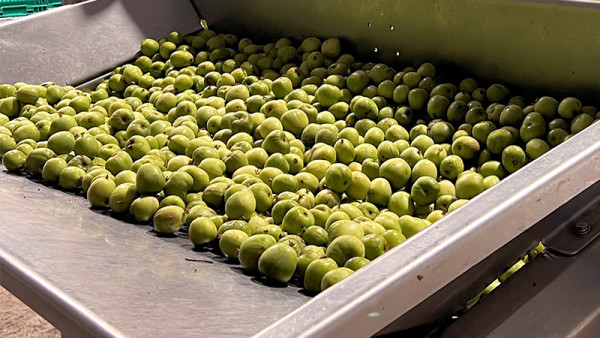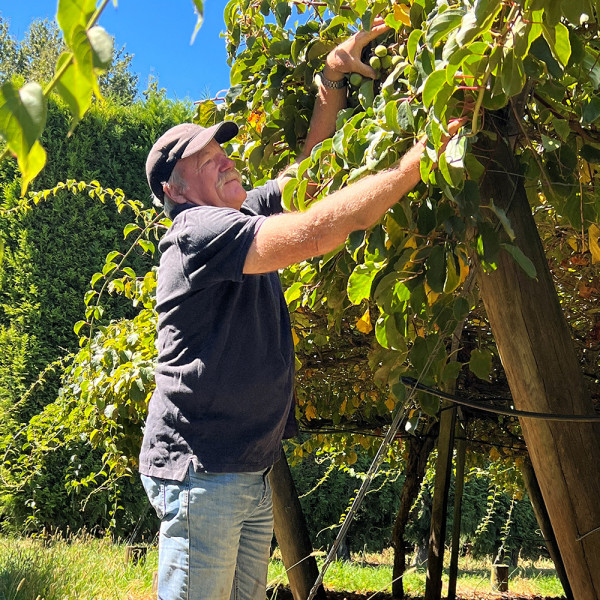Good season for kiwiberries despite challenges
13 April 2022
Written by Helena O’Neill
First published in the April 2022 issues of The Orchardist.

Yieldia kiwiberries on the grading machine at Paengaroa.
With the New Zealand kiwiberry season coming to a close, Helena O’Neill speaks with Paengaroa orchardist Geoff Oliver about the bite-sized fruit.
Near the affectionately dubbed ‘Kiwifruit Capital of the World’ of Te Puke, Geoff Oliver grows 6ha of kiwiberry across three orchards. He also grows green, gold and red kiwifruit, along with avocados, managing 85ha of orchards in total.
Kiwiberries are small (usually between 5g and 20g) with smooth hairless edible skins, and shapes varying from round to elongated. Like grapes they are a single mouthful, but unlike grapes they are considered a superfood due to the high density of vitamins, minerals, pigments and phenols.
Geoff says they really are packed full of essential nutrients and a great booster for your immune system. He’s been growing kiwiberry on his Paengaroa orchards since they were first trialed about 14 years ago. Geoff is also the chairman of the New Zealand Kiwiberry Grower Association.
Kiwiberry (or baby kiwi as they are known in some countries) is the name used in New Zealand for Actinidia arguta. The fruit grows wild in parts of China and is also found in north-eastern Siberia, Korea and Japan. Globally there is thought to be less than 200ha planted for commercial production.
Harvested between early February and mid-March, the New Zealand kiwiberry is recognised globally for its high quality and nutritional value. It has higher levels of vitamin C (gram for gram) than kiwifruit and oranges. The New Zealand commercial industry grows three main varieties: K2D4, Marju Red and Takaka Green which all provide slightly different flavours. They have been developed through private and Hort Research breeding programmes to develop varieties best suited to the New Zealand growing conditions.
The main producing countries who supply the international market are New Zealand, the United States, Canada and Chile.
“New Zealanders are probably the highest consumers of kiwiberries per head of population. The returns aren’t as good as export so it’s not viable to grow just for the domestic market.
“There’s still a lot of potential, particularly around food service and in restaurants, which are both under a lot of pressure at the moment. One of our big markets is Australia, so we can airfreight it over there very quickly.”
Due to the limited shelf-life, the fruit for export can only be transported by airfreight.
“It’s a fruit that doesn’t have a hugely long shelf-life so it doesn’t travel that well. The Asian markets are the best for us. As for the United States, we compete with Chile who produce cheaper kiwiberries but lower quality. They also fruit earlier so they control that market.”
It’s also a nervous and exciting wait for growers as efforts are underway to re-enter the Chinese market.
“Right at the moment we are very close to getting back into China. We had access there up until 2016 when Chinese authorities reviewed the kiwifruit category and we were dropped off.”
Returning to the Chinese market will help increase prices and make it more viable for kiwiberry growers, Geoff says.
“Last year and this year the freight rates have gone up and the range of services is a lot more limited, with less planes flying. Overall, it's been a net extra cost for growers. Hopefully in the future we can get back to something more reasonable.”
Numbers of kiwiberry growers have dropped over the past few years while returns have been lower, Geoff says. There are only around 25 commercial kiwiberry growers in the country.
“If you get really good production and good yields, you will do well. It’s the same with every crop.”

Geoff Oliver inspecting kiwiberries in the orchard.
Kiwiberries are grown in the same areas as kiwifruit, with the same structures and the same layout (every second row is male). Kiwiberry does have a very high winter pruning cost, he says.
Like their larger counterparts, kiwiberries are susceptible to thrips and scale, although the scale is only on the leaf, not the fruit, when the fruit is harvested.
“Overall, this season’s New Zealand production will be down slightly. The extra rain in January meant thicker canopies causing some softer fruit and a little more fruit drop, but prices have remained good at around $28 to $30 a tray.”
Picking the smaller fruit is a lot more labour intensive, meaning it is more expensive to pick.
“It costs around $1.50 a kilo to pick initially, rising to $3 a kilo for the second pick. It’s not like green or gold where you can pay by the bin or container, it is best to pay by the hour and get the quality pick for the job. When you’re picking a green or a gold fruit, one fruit is about four or five kiwiberries.”
Like the kiwiberry harvest, the national red kiwifruit harvest has wrapped up, but Geoff is already picking gold kiwifruit across his orchards starting late last month [March], a little earlier than previous years.
Finding enough staff to pick and pack fruit remains a big concern for Geoff and other growers.
“It will get pretty competitive between different sites with such a limited labour force. It’s going to be a massive challenge for the industry from now until the beginning of June, to get everything picked and packed.
“We have a small packhouse here where we pack a range of crops, and we’re 40 percent down on staff today due to Covid-19.”
The packhouse arm of operations is rebranding from Kiwi Produce to Yieldia. It was established in 1986 as a specialist kiwifruit packhouse, pre-packer and distributor. It is operational 12 months of the year and handles a large range of New Zealand produce including avocados, kiwifruit, feijoas, kiwiberry, citrus, passionfruit and other sub-tropical fruits.
Yieldia packs over 2 million tray equivalents of locally grown fruit a year and employs 60 staff at the peak of the season. The site also incorporates six fully-monitored coolstores. Newer products include Kiwilicious Dried Kiwifruit and Kiwilicious IQF (Individually Quick Frozen) Kiwifruit.
